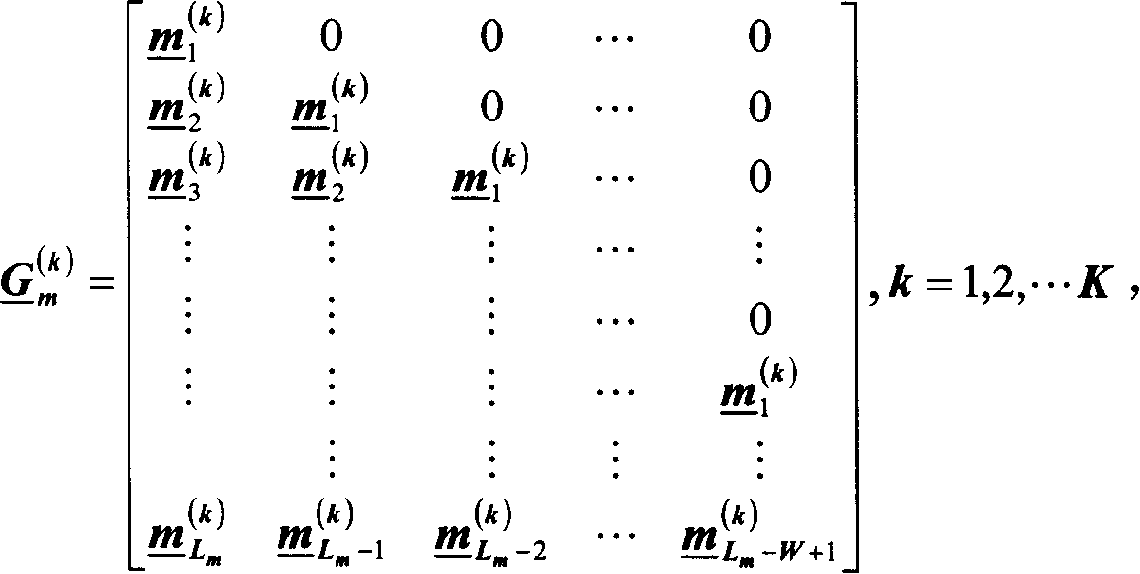Method of estimating power of interference signal code
A technology of interference signal code and power, which is applied in the field of estimating the interference signal power of the intermediate pilot received signal, can solve the problems of estimation value deviation, failure to obtain power estimation value, and influence on interference signal code power estimation accuracy, etc., and achieve high accuracy Effect
- Summary
- Abstract
- Description
- Claims
- Application Information
AI Technical Summary
Problems solved by technology
Method used
Image
Examples
no. 1 example
[0103] The first embodiment of the present invention, as shown in Figure 2, comprises the following steps:
[0104] 1. First, eliminate the influence of the data segment on the intermediate pilot received signal, thereby generating a new set of intermediate pilot received signals;
[0105] assume e new Represents the mid-pilot received signal after eliminating the influence of the data segment, referred to here as the new mid-pilot received signal, where the first (W-1) elements of the new mid-pilot received signal are the same as the original mid-pilot received The signals are different, and other elements are the same as the elements at the corresponding positions of the original mid-pilot received signal, so the new mid-pilot received signal can be expressed as
[0106] e ¯ new = ( e ¯ ...
no. 2 example
[0120] In the second step above, the pilot convolution matrix can be extended to a general form. The general form of the pilot convolution matrix differs from the original pilot convolution matrix in that: the general pilot convolution matrix G m,general The columns of is not less than the columns of the original pilot convolution matrix G m , while the columns of the latter must be included in the former. Since the intermediate pilot signals of different users are constructed by cyclically shifting the same basic pilot sequence, the constructed cyclic offset is determined by the maximum allowable number set by the system. When the number of intermediate pilot sequences currently existing in the system is equal to the maximum allowable number, the general pilot convolution matrix G m,general with G m is consistent. That is to say, even if some intermediate pilot sequences do not exist at the present moment, we can still pretend that these intermediate pilot sequences ...
no. 3 example
[0138] The method for the third implementation example is shown in Figure 4, and its specific steps are as follows:
[0139] 1. First eliminate the influence of the data part on the received signal of the intermediate pilot, thereby obtaining a new set of received signals of the intermediate pilot;
[0140] assume e new Represents the received mid-pilot signal after eliminating the influence of the data segment, referred to here as the new mid-pilot received signal, where the first (W-1) elements of the new mid-pilot received signal are the same as the original mid-pilot received signal different, other elements are the same as the elements at the corresponding positions of the original intermediate pilot received signal, then the new intermediate pilot received signal can be expressed as:
[0141] e ¯ new = ( e ¯ ...
PUM
 Login to View More
Login to View More Abstract
Description
Claims
Application Information
 Login to View More
Login to View More - R&D
- Intellectual Property
- Life Sciences
- Materials
- Tech Scout
- Unparalleled Data Quality
- Higher Quality Content
- 60% Fewer Hallucinations
Browse by: Latest US Patents, China's latest patents, Technical Efficacy Thesaurus, Application Domain, Technology Topic, Popular Technical Reports.
© 2025 PatSnap. All rights reserved.Legal|Privacy policy|Modern Slavery Act Transparency Statement|Sitemap|About US| Contact US: help@patsnap.com



